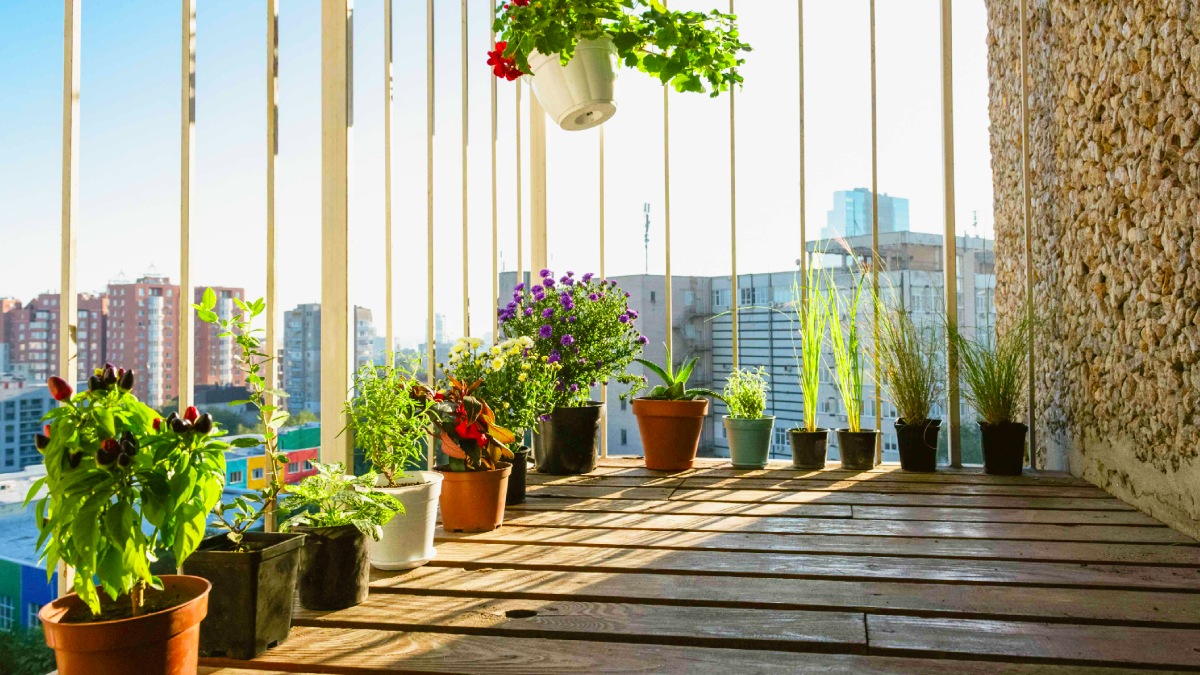
Growing plants in a small space like a balcony or terrace can be difficult, even for an experienced gardener who is a perfectionist, but it’s also the best opportunity to be creative and have fun.
From the start of deciding what to grow (an urban vegetable garden? a tropical paradise?) to selecting imaginative containers (such as an old watering can or wood crate), the entire process can be an adventure. Yes, you still must adhere to the strict confines of your space, but there are many tricks for making every square inch count. Here are some tips to help you get started:
Maximize your space
How much space do you need for a balcony garden? Amazingly, not very much if you take advantage of walls, railings, and overhead structures.
Turn your balcony into a vertical garden. Add pots, shelves, or trellises to the walls, and if your balcony consists of a ceiling, implement a few hooks for hanging plants.
Plan your balcony garden as an extension of your indoor living space. If you select plant colors and textures that echo the interior design, even the smallest balcony will look more costly and welcoming.
KNOW YOUR RESTRICTIONS
In addition to the square footage of your balcony, there may be other limitations that will limit what you can plant and where. If you live in an apartment building, be sure to check what’s permitted by the building owner before you begin.
Weight: There may be weight restrictions and rules contrasting what you can hang from balcony railings and walls. If the balcony is attached to your home, be familiar with how much weight it can support. The weight from large ceramic containers and wet soil can add up rapidly.
Microclimate: The amount of sunlight the space delivers is the most important factor to consider, but wind exposure and temperature are also mandatory.
Wind: Strong winds, which are common on balconies and rooftop gardens, can quickly dry out the soil, rip the petals off flowers, and knock over high-potted plants.
Heat: Sun reflecting from windows can escalate the heat of a balcony garden and damage delicate foliage. Even the basic construction of your balcony will affect how much heat it attains.
Shade: Many urban balconies receive a bit of shade if they are surrounded by large buildings. Often, you can work around this trouble by putting sun-tolerant plants near the perimeter of the balcony, where the sun is more prevalent.
Tip: If wind is a concern on your balcony, prefer using balcony privacy screens as windbreaks to save more fragile plants. You can also put plants that hate the wind in low pots near a wall to give them more safety.
HOW DO YOU WATER A BALCONY GARDEN?
Rooftop gardens or a few balconies have access to an outside water source, which means you’ll have to rely on water from a sink to keep your plants well-hydrated. To reduce your trips back and forth lugging heavy containers of water, try some of the following strategies for watering your plants:
If you have lots of plants to water, consider investing in a large, lightweight watering can that you can fill in the bathtub. Use watering cans to save more space for balcony gardens because they can be flattened when not in use.
Put saucers or trays under your plants to collect any water overflow so you don’t waste a drop. Self-watering pots, for example, AquaPots, can also help to save water and decrease watering frequency.
Remove watering cans by buying a lightweight, expandable garden hose that you can fix to a kitchen sink using an adapter. They come in lengths as long as 100 feet and retract when not in use for accurate storage.
Keep in mind that the hotter and windier the conditions on your balcony, the more frequently you’ll need to water—sometimes as often as twice a day. If a convenient water source is far from reach,then prefer growing plants with low water needs; examples are cacti and succulents.
WHAT CAN YOU GROW IN A BALCONY GARDEN?
Just about any plant you can grow in a container is fair game for a balcony garden, as long as you have the space for it and can give it the appropriate amount of sun or shade. If you live in a climate with a cold, prefer growing some plants that are hardy enough to leave outdoors year-round so you don’t have to start from scratch again every spring.
Herbs
Vegetables
Examples of small trees include dwarf citrus trees.
Small shrubs
Container-friendly annuals and perennials for shade or sun
Succulents
Tropical houseplants, for example, spider plants
Flowering vines and other climbing plants if you have a trellis or other vertical support.
WHAT CONTAINERS ARE BEST FOR A BALCONY GARDEN?
Anything that can hold soil and has good drainage has potential for a balcony container garden.The style can vary from fancy to frivolous, depending on your choices, but the container should be practical and serve the purpose.
Plastic and fiberglass plant containers are suggested for balcony gardens because they’re lighter in weight than ceramic pots and come in a vast variety of styles and sizes. However, on windy balconies, they can be blown over easily unless they’re secured in place.
Also Read – 10 Home Garden Ideas To Infuse Simple Beauty Into Your Outdoor Space
Fabric grow bags are lightweight container options, with the added benefit of being easy to store after the growing season is finished. They also have a tackle for more approachable portability.
Hanging baskets and outdoor railing baskets are space saviors and can be used to grow everything from herbs to houseplants.
Tiered planters are also a space-saving solution that permits you to use vertical space for your garden instead of taking up important space on your balcony floor.
